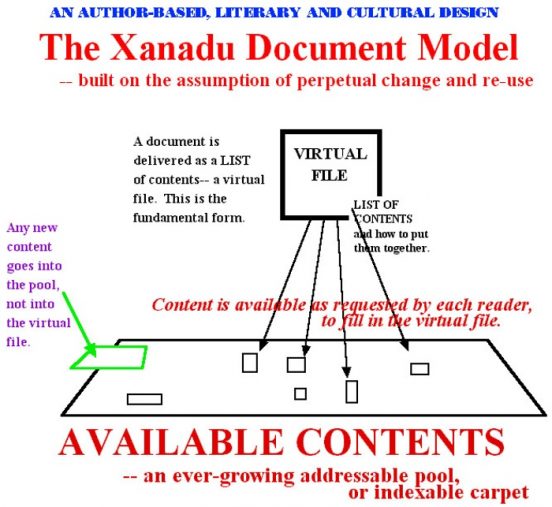I was most fascinated by Project Xanadu. In short, it is a version of the world wide web that never came to be; but in my opinion it was the better one. Its development was not championed except for by a very few. Perhaps it was misunderstood or poorly advocated; in either case we are certainly worse off for it.
Project Xanadu was the unrealized creation of Theodor Nelson in which in which only one version of each piece of information existed, and links were never broken.
In its current state, the internet has no “top” – it can be entered from any of a million ways (Wesch, 2007). Vannevar Bush, creator of the Memex (memory + index, a proto-hypertext system) noted the issues with indexing: “our ineptitude in getting at the record is largely caused by the artificiality of systems of indexing.” Bush continues, stating that effective indexing would allow us the “privilege of forgetting” the things we don’t immediately need, with some assurance that we’ll be able to find them later if required. Nelson describes his own ingenious invention succinctly: “Xanalogical literary structure offers uniquely integrated methods for version management, side-by-side comparison and visualizable re-use, which lead to a radically beneficial and principled copyright system”. WOW.
Until I read the article in which Nelson reveals his idea to the world I assumed I was alone in my perplexity with having to keep little bread crumb trails for myself of every site that I visited while researching (a task only slightly aided by referencing software and bookmarking sites, which add their own complexity), what I had gleaned from each site, and whether I might possibly be using an exact quote knowing that I would need to cite it later. Imagine this… how valuable would it be to be able to compare document versions side-by-side, so that one would know WHAT HAS CHANGED instead of having to read, understand, make sense of and even make notes on each version? And instead of hyperlinks, we would have had transclusions – better than links because they connect to the original, revealing the true relationship. Transclusions are a fundamental attribute of the internet, and because they cannot be accomplished on paper would have been invaluable. Nelson had already solved all these problems by foreseeing them before they came to pass; the real heartbreak being of course that the mess the internet is today might have been avoided. Project Xanadu, a pristine, glittering organizational structure with a single version of everything. A single version of the truth.
But we didn’t use the internet for that. Instead we have “fragile ever-breaking one-way links, with no recognition of change or copyright, and no support for multiple versions or principled re-use. Fonts and glitz, rather than content connective structure, prevail.” (Nelson, 1999). In most circles these days Nelson is thought a madman, suffering the same fate of every unsuccessful genius. Maybe we should have listened.
References
Bush, V. (1945). As we may think. The Atlantic Monthly, 176(1), 101-108. Available: http://www.theatlantic.com/doc/194507/bush
Englebart, D. (1962). Comments Related to Bush’s Article. Augmenting Human Intellect: A Conceptual Framework. Retrieved from: http://web.archive.org/web/20080331102459/http://www.bootstrap.org:80/augdocs/friedewald030402/augmentinghumanintellect/3examples.html#A.2
Nelson, Theodore. (1999). “Xanalogical structure, needed now more than ever: Parallel documents, deep links to content, deep versioning and deep re-use.” Available:
http://www.cs.brown.edu/memex/ACM_HypertextTestbed/papers/60.htm
Wesch, M. (2007). Information R/evolution. (Video). Retrieved from https://www.youtube.com/watch?v=-4CV05HyAbM
Image
Scholl, F. (2014). Project Xanadu Finally Released After 54 Years. Retrieved from https://techdissected.com/web-and-computing/project-xanadu-finally-released-after-54-years/






EdPawliw
August 1, 2018 — 9:16 pm
I too was most interested in Dr. Nelson’s vision after reading on it. From my research, it looks like Nelson and Xanadu had a number of challenges along the way. Nelson, as he admits himself, had no patience for those who did not understand and he had a hard time conveying the concept. He was not a computer programmer or an IT guy. Due to this, when he would present the system, he would not be able to speak from other than the concept level. When the concept was picked up by AutoDesk, he was there as basically a figurehead and decisions were made that ran contrary to the vision. Also, he tried many times to develop the concept without financial backing, so he didn’t have the critical mass to complete rapid development. He did have backing from Keio University in Japan and produced a working system, but by this time, our current version of hypertext and the internet was already too ingrained and had too much momentum to change, no matter if there was a better system out there.
As you mention, the linking system envisioned by Nelson is the key to Xanadu. Being able to dynamically link across documents, but also across versions makes for not only direct and active referencing, but also context. Having the link history also enables one to see past linkages which in turn builds a more rigorous supporting relational document system for the researcher, peers and others to follow.
The Xanadu system creates a completely different referencing system. How the academic community would react would be interesting to see. Would one still be required to have a reference section at the end of the document if everything was live linked? Also, with links outside the text that is referenced creates for clean text that is not polluted with embedded link code. This allows for the exact type of partial linking that enables graphically showing document linkage.
The W3C (World Wide Web Consortium), which was created by Tim Berners-Lee, is proposing that Web 3.0, the next major iteration of our internet experience, will be the semantic web. An experience that will have the deeper connections and provide for a richer experience similar to what Nelson envisioned.
As an aside, here is a link to an article that came across my news feed on why Tim Berners-Lee wants a redo for the internet: https://www.thestar.com/business/opinion/2018/07/30/why-the-webs-inventor-wants-to-take-back-his-invention.html . Berners-Lee, in the article states we need to “radically change the way the Web applications work today, resulting in true data ownership [emphasis mine] as well as improved privacy.” (Berners-Lee in Wells. 2018). Sounds a bit like good ole Tim sees that Ted was on to something all this time…
References:
Bratt, S. (2007). World Wide Web Consortium: Web 3.0 Emerging. [online] W3.org. Available at: https://www.w3.org/2007/Talks/0123-sb-W3CEmergingTech/Overviewp.pdf [Accessed 29 Jul. 2018].
Dechow, Douglas R., Struppa, Daniele C., Intertwingled. The Work and Influence of Ted Nelson. Springer International Publishing AG Switzerland
Nelson, T. (n.d.). The Ted Nelson You Tube Channel. Retrieved from https://www.youtube.com/user/TheTedNelson
Nelson, T. (n.d.). Ted Nelson Home Page. Retrieved from http://www.xanadu.com.au/ted/
Wells, J. (2018, July 30). Why the Web’s inventor wants to take back his invention. Retrieved from https://www.thestar.com/business/opinion/2018/07/30/why-the-webs-inventor-wants-to-take-back-his-invention.html